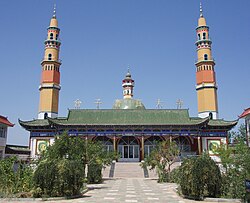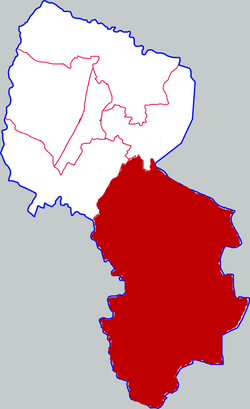Lingwu
Lingwu 灵武市 · لِئٍوُ شِ | |
|---|---|
 | |
 Location of Lingwu in Yinchuan | |
| Coordinates: 38°06′11″N 106°20′24″E / 38.103°N 106.340°E | |
| Country | China |
| Region | Ningxia |
| Prefecture-level city | Yinchuan |
| Municipal seat | Chengqu Subdistrict |
| Area | |
• Total | 3,009.04 km2 (1,161.80 sq mi) |
| Population (2010 census) | |
• Total | 261,677 |
| • Density | 87/km2 (230/sq mi) |
| Time zone | UTC+8 (China Standard) |
Lingwu (simplified Chinese: 灵武市; traditional Chinese: 靈武市; pinyin: Língwǔ Shì, Xiao'erjing: لِئٍوُ شِ) is a county-level city of Ningxia Hui Autonomous Region, Southwest China, it is under the administration of the prefecture-level city of Yinchuan. It is the most important industrial city of Ningxia.[citation needed] Lingwu spans an area of 3,846 square kilometres (1,485 sq mi),[1] and according to the 2010 Chinese census, Lingwu has a population of 261,677.[2]
Toponymy
Lingwu was historically known as Lingzhou (simplified Chinese: 灵州; traditional Chinese: 靈州; pinyin: Língzhōu, Xiao'erjing: لِئٍجِوْ).[3]
History
During the Warring States period, the area was absorbed into the Qin dynasty under Beidi Commandery.[2] The area was first incorporated into the Han dynasty in 191 BCE by Emperor Hui.[2][3] In 437 CE, under the Northern Wei, the area was incorporated as Bogulu Town.[2] In 526 CE, Bogulu Town was renamed as Lingzhou.[2] In 756 CE, during the Tang dynasty, Emperor Suzong fled to Lingzhou during the Anshi Rebellion,[2] where he ascended the throne with the aid of loyal bureaucrats and military supporters, only notifying his father Xuanzong after the fact.[citation needed] Lingzhou became part of the Western Xia in 1038.[2] It was besieged by Genghis Khan in November 1226.[citation needed]
On May 20, 1996, Lingwu was upgraded from a county to a county-level city.[2] On October 25, 2002, Lingwu was transferred from the prefecture-level city of Wuzhong to Yinchuan.[2]
Geography
The western border of Lingwu is formed by the Yellow River.[1]
Climate
Lingwu's climate is arid, with little precipitation and high levels of sunshine.[1]
| Climate data for Lingwu, elevation 1,116 m (3,661 ft), (1991–2020 normals, extremes 1981–2010) | |||||||||||||
|---|---|---|---|---|---|---|---|---|---|---|---|---|---|
| Month | Jan | Feb | Mar | Apr | May | Jun | Jul | Aug | Sep | Oct | Nov | Dec | Year |
| Record high °C (°F) | 12.9 (55.2) |
21.1 (70.0) |
27.1 (80.8) |
34.3 (93.7) |
36.0 (96.8) |
36.6 (97.9) |
37.5 (99.5) |
36.3 (97.3) |
35.2 (95.4) |
29.0 (84.2) |
24.3 (75.7) |
16.0 (60.8) |
37.5 (99.5) |
| Mean daily maximum °C (°F) | 0.8 (33.4) |
5.9 (42.6) |
12.9 (55.2) |
20.6 (69.1) |
25.2 (77.4) |
28.9 (84.0) |
30.4 (86.7) |
28.7 (83.7) |
24.2 (75.6) |
18.0 (64.4) |
9.2 (48.6) |
2.1 (35.8) |
17.2 (63.0) |
| Daily mean °C (°F) | −7.0 (19.4) |
−2.5 (27.5) |
4.8 (40.6) |
12.4 (54.3) |
17.6 (63.7) |
21.8 (71.2) |
23.7 (74.7) |
21.8 (71.2) |
16.3 (61.3) |
9.0 (48.2) |
1.9 (35.4) |
−5.0 (23.0) |
9.6 (49.2) |
| Mean daily minimum °C (°F) | −13.3 (8.1) |
−9.2 (15.4) |
−2.1 (28.2) |
4.3 (39.7) |
9.4 (48.9) |
14.2 (57.6) |
17.1 (62.8) |
15.5 (59.9) |
9.8 (49.6) |
2.0 (35.6) |
−3.5 (25.7) |
−10.5 (13.1) |
2.8 (37.1) |
| Record low °C (°F) | −26.5 (−15.7) |
−26.6 (−15.9) |
−20.4 (−4.7) |
−8.3 (17.1) |
−3.1 (26.4) |
4.6 (40.3) |
8.8 (47.8) |
4.8 (40.6) |
−2.7 (27.1) |
−11.6 (11.1) |
−17.8 (0.0) |
−25.1 (−13.2) |
−26.6 (−15.9) |
| Average precipitation mm (inches) | 1.3 (0.05) |
2.1 (0.08) |
5.2 (0.20) |
11.1 (0.44) |
19.4 (0.76) |
27.4 (1.08) |
39.0 (1.54) |
40.9 (1.61) |
30.1 (1.19) |
12.1 (0.48) |
4.4 (0.17) |
1.0 (0.04) |
194 (7.64) |
| Average precipitation days (≥ 0.1 mm) | 1.5 | 1.1 | 2.3 | 3.6 | 4.7 | 5.9 | 7.5 | 7.9 | 6.6 | 4.1 | 1.9 | 0.9 | 48 |
| Average snowy days | 2.6 | 1.7 | 1.3 | 0.4 | 0 | 0 | 0 | 0 | 0 | 0.3 | 1.6 | 1.3 | 9.2 |
| Average relative humidity (%) | 53 | 46 | 42 | 39 | 48 | 57 | 65 | 70 | 71 | 64 | 60 | 56 | 56 |
| Mean monthly sunshine hours | 209.0 | 210.1 | 249.5 | 271.1 | 301.5 | 298.0 | 295.0 | 267.0 | 225.6 | 237.7 | 215.6 | 213.2 | 2,993.3 |
| Percent possible sunshine | 68 | 68 | 67 | 68 | 68 | 68 | 66 | 64 | 61 | 69 | 72 | 72 | 68 |
| Source: China Meteorological Administration[4][5] | |||||||||||||
Administrative divisions
Lingwu administers one subdistrict, six towns, two townships and one other township-level division.[6]
Subdistricts
The city's sole subdistrict is:
- Chengqu Subdistrict (城区街道, چٍْٿِيُوِ ڭِيَدَوْ).[6]
Towns
The city's six towns are:
- Dongta (东塔镇, دْوتَا جٍ
- Haojiaqiao (郝家桥镇, خَوْڭِيَاٿِيَوْ جٍ)
- Chongxing (崇兴镇, چْوثٍْ جٍ)
- Ningdong (宁东镇, نِيٍدْو جٍ)
- Majiatan (马家滩镇, مَاڭِيَاتًا جٍ), and
- Linhe (临河镇, لٍحَ جٍ).[6]
Townships
The city's two townships are:
- Wutongshu Township (梧桐树乡, وُطْوشُ ثِيَانْ), and
- Baitugang Township (白土岗乡, بَيْتُقَانْ ثِيَانْ).[6]
Other township-level divisions
The city also administers the township-level division of:
- Lingwu Farm (灵武农场, لِئٍوُ نْوچَانْ).[6]
Demographics
Lingwu's population was reported as 261,677 in the 2010 Chinese census.[2] In the 2000 Chinese census, the city's population was 249,890.[2] The city has a Hui majority population.
Economy
The city has significant coal, natural gas, and petroleum reserves.[3] Lingwu has a proven coal reserve of 27.3 billion tons.[3]
Lingwu also has a significant agricultural sector, with rice, wheat, corn, and jujubes all being grown in the city.[3] The city is well known for its "Lingwu long jujube" (Chinese: 灵武长枣).[3] This fruit has proven to be one of Ningxia's most popular agricultural products, producing an income of over 10 million yuan per year.[7]
Notable sites
- Zhenhe Pagoda (Chinese: 镇河塔)[1]
- Shuidonggou Ruins[1]
- Portions of the Ming Great Wall[1]
See also
- Empress Erzhu (Yuan Ye's wife)
- Gao Huan
- Lingwulong, named after Lingwu
- Yuwen Tai
References
- ^ a b c d e f 灵武市概况地图 [Lingwu Overview]. xzqh.org (in Chinese). 2016-07-19. Archived from the original on 2021-03-31. Retrieved 2021-03-31.
- ^ a b c d e f g h i j k 灵武市历史沿革 [Lingwu Organizational History]. xzqh.org (in Chinese). 2016-07-19. Archived from the original on 2020-09-28. Retrieved 2021-03-31.
- ^ a b c d e f 灵武概况 [Lingwu Overview] (in Chinese). Lingwu Municipal People's Government. 2021-01-05. Archived from the original on 2021-03-31. Retrieved 2021-03-31.
- ^ 中国气象数据网 – WeatherBk Data (in Simplified Chinese). China Meteorological Administration. Retrieved 26 August 2023.
- ^ 中国气象数据网 (in Simplified Chinese). China Meteorological Administration. Retrieved 26 August 2023.
- ^ a b c d e 2020年统计用区划代码 [2020 Statistical Division Codes] (in Chinese). National Bureau of Statistics of China. 2020. Archived from the original on 2021-03-31. Retrieved 2021-03-31.
- ^ Liu, Chengjun; Tang, Yi (2006-09-25). 灵武长枣正向规模化、标准化和产业化方向发展 [Lingwu long jujube is developing towards scale, standardization and industrialization] (in Chinese). Ministry of Commerce of the People's Republic of China. Archived from the original on 2012-11-27. Retrieved 2021-03-31.
External links
- Lingwu Government Website (2021) (Chinese)
- Lingwu Government Website (2007) (Chinese)
- Satellite map of Lingwu

